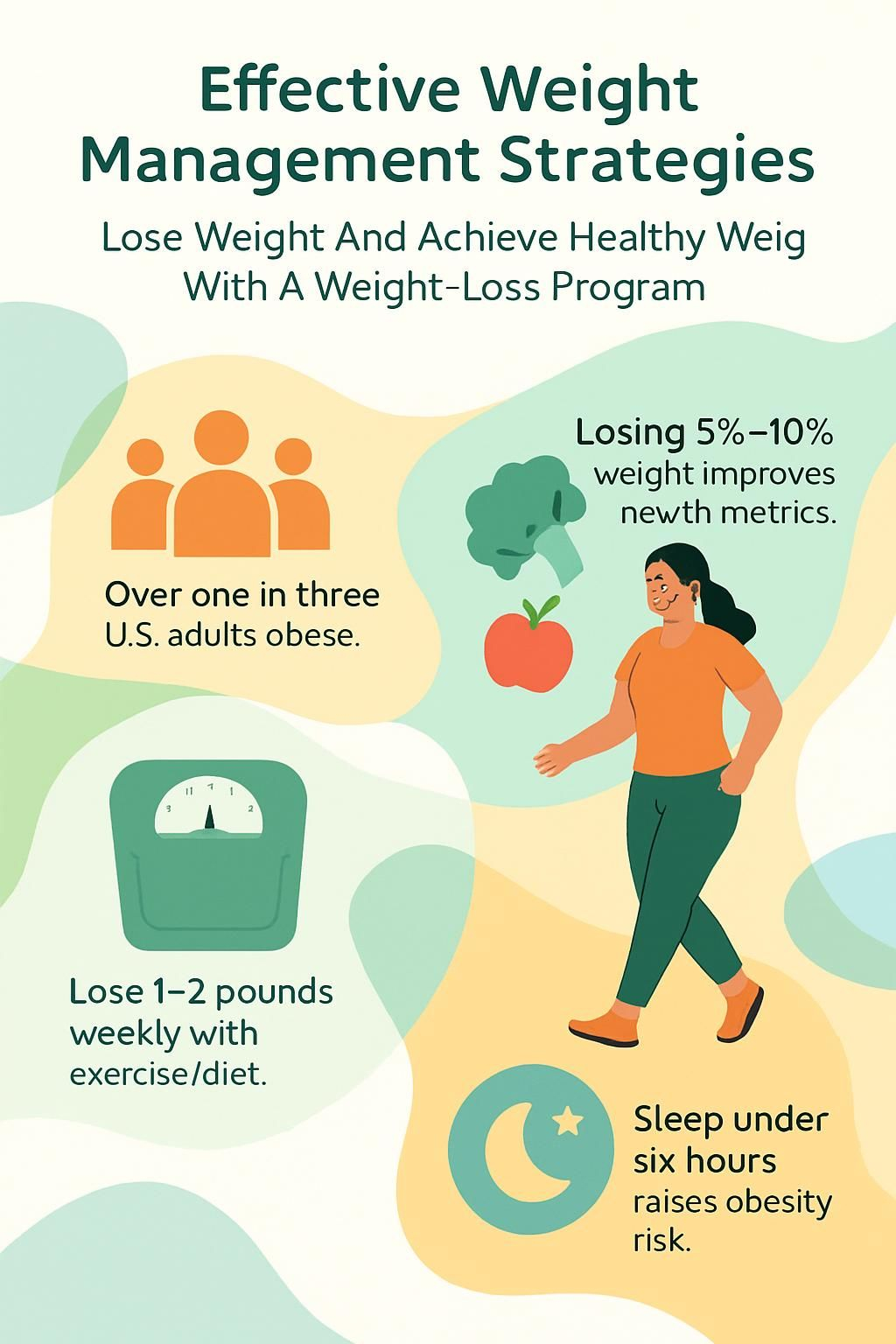Effective Weight Management Strategies: Lose Weight And Achieve Healthy Weight With A Weight-Loss Program
Our Nutrition Assistant AI Suite will transform your body. You will lose fat, get toned, and build muscle. Gain confidence and optimal health.
If you struggle to manage your weight or lose weight even after trying many plans, you are not alone. In the United States, more than one in three adults lives with obesity, a condition that raises the risk of type 2 diabetes and heart disease. Evidence-based weight management can help you set clear goals, follow a healthy eating plan, and build regular physical activities into your week.
This guide shows practical steps that fit real life. Small, steady changes add up and support long-term weight control. Use these ideas to take control of your health and move toward a healthy weight at your own pace.
Key Takeaways
- Over one in three U.S. adults has obesity, which raises risk for type 2 diabetes, heart disease, and some cancers, according to the National Institutes of Health.
- Losing 5% to 10% of body weight can improve blood sugar, cholesterol, and blood pressure, as shown in NIH research.
- Experts advise losing 1 to 2 pounds per week using a calorie deficit, balanced meals with half your plate fruits and vegetables, and at least 150 minutes of weekly exercise.
- Sleeping under six hours a night increases obesity risk by 55%. Stress control reduces overeating, according to studies in nutrition journals.
- Structured programs, such as NYU Langone’s Weight Management Program, provide personal plans and professional support, including surgery options, which improve long-term weight maintenance.

Why Weight Management Matters

Healthy weight management protects your organs, joints, and energy levels. Strong routines around food, movement, sleep, and stress can prevent many weight-related conditions.
Why is maintaining a healthy weight important?
Staying in a healthy weight range lowers the chances of several chronic illnesses. Extra body fat strains the heart and affects hormones that control blood sugar and appetite. Even modest weight loss helps. Losing just 5% of your weight can lower blood pressure, improve cholesterol, and support better blood sugar control.
The National Institutes of Health reports that dropping as little as 10 pounds can improve health for adults with overweight or obesity. That change also reduces pressure on your hips and knees, which may ease pain and help you move more. Good nutrition and enough sleep make these gains more likely to last.
What health risks come with being overweight or obese?
Carrying excess weight increases the risk for type 2 diabetes, high blood pressure, and heart disease. Stroke risk rises as blood pressure climbs. Fatty liver disease can develop even if you do not drink alcohol. Sleep apnea, GERD, and gallstones also become more common.
Joint pain, kidney disease, skin infections in skin folds, infertility in women, and some cancers, including colon and breast cancer, occur more often too. High cholesterol adds stress to the cardiovascular system. Clinical trials from the National Institute of Diabetes and Digestive and Kidney Diseases continue to confirm these links.
Increased body weight raises your chances of developing major illnesses that impact daily living, says Dr. Anna Fox, a leading physician in clinical research on metabolic syndrome.
Setting and Understanding Your Weight Loss Goals
Clear goals guide your daily choices. A specific target makes it easier to measure progress and stay motivated through setbacks.
Why should I set realistic weight loss goals?
Very aggressive goals, like trying to lose 20 pounds in two weeks, can backfire. Most health professionals suggest aiming for 1 to 2 pounds per week. That pace is safer and easier to maintain. Small, specific goals help you track progress and adjust without giving up.
Limit yourself to two or three goals at a time. Keep them measurable and doable, such as increasing vegetables at lunch or walking 20 minutes after dinner. A registered dietitian or your health care provider can help set goals that fit your age, medical history, and schedule.
How do I find my personal reason for losing weight?
Knowing your “why” keeps you focused when progress slows. Think about your health risks, family history, or daily activities that matter to you. Maybe you want more energy to play with your kids. Maybe you want to lower your chance of diabetes or heart disease.
Write down the reasons that matter most. Keep them where you can see them every day. Purpose fuels consistency, and consistency builds long-term habits.
Effective Weight Management Strategies
Evidence-based strategies combine a healthy eating plan, physical activity, stress control, and sleep. These parts work together like pieces of a simple toolkit.
How can I adopt a balanced and healthy eating plan?
Follow trusted guidance such as MyPlate and the Dietary Guidelines for Americans. Fill half your plate with vegetables and fruits. Choose lean proteins like chicken, fish, eggs, tofu, or beans. Add whole grains such as brown rice, oats, or whole wheat pasta.
Control portions with smaller plates and check serving sizes on labels. Track your meals to spot patterns linked to weight gain. Limit added sugars and saturated fat. Shape your plan to fit your budget, culture, and routine so it lasts.
What types of physical activity should I include regularly?
Mix aerobic activity, strength training, and flexibility work. Aim for at least 150 minutes each week of moderate aerobic activity, for example brisk walking, cycling, or swimming. Shorter sessions add up, such as three 10-minute walks per day.
Do strength training at least two days per week to maintain muscle and support metabolism, your body’s energy use. Add stretching or yoga to improve range of motion and reduce injury risk. Pick activities you enjoy so you keep doing them.
How can managing stress help with weight control?
Stress can lead to cravings for high-calorie snacks and larger portions. It can also disrupt hormones that regulate appetite. Track your stress triggers and notice how they affect your food choices.
Practice simple tools, such as deep breathing, a short walk, or a brief stretch break. Try mindful eating, which means slowing down, noticing hunger and fullness, and eating without screens. These steps make it easier to stay in control of portions and stick with your plan.
Why is getting enough sleep important for weight loss?
Sleep affects hunger hormones. Too little sleep raises ghrelin, which increases hunger, and lowers leptin, which signals fullness. A study found adults who slept fewer than six hours per night had a 55% higher risk of obesity over time compared with those sleeping seven to eight hours [1].
Lack of sleep can also slow your basal metabolic rate, the energy your body uses at rest. Track your sleep for a few weeks. Aim for a regular bedtime, a dark room, and limited caffeine after lunch. Better sleep supports better choices the next day.
Next, see how to track habits and turn goals into steady action for lasting change.
Steps to Lose Weight
Consistent steps, not perfect days, drive results. Use simple tools to monitor progress and adjust early.
How do I track my current habits and progress?
- Use a food and drink diary every day. Track what, when, and why you eat. Patterns become clear fast.
- Log all physical activity, including type, duration, and time of day. This shows what supports your routine.
- Record your sleep hours. Adults generally need 7 to 9 hours for best health, according to CDC guidance.
- Note your stress level and coping tools, such as breathing, a walk, or a short talk with a friend.
- Set action goals like “walk 30 minutes after dinner” or “water with lunch.” Concrete actions beat vague plans.
- Weigh in weekly at the same time and on the same scale. Track measurements like waist or hips once a month.
- Review your logs every week. Keep habits that help. Tweak habits that stall progress.
- Share tracking details with a care team if you are using medication or being evaluated for bariatric surgery.
How can I set specific and achievable weight-loss goals?
- Pick simple, positive actions such as “replace soda with water” or “walk after work.”
- Work on two or three goals at once. Too many changes at once can overwhelm you.
- Use numbers. Target a loss of 1 to 2 pounds per week if your doctor agrees.
- Choose enjoyable activities. If you dislike running, try cycling, dancing, or swimming.
- Track daily. Logging food and activity is linked to greater weight loss.
- Plan for barriers like parties or low-motivation days. Decide in advance how you will respond.
- Align goals with your health status and any medical advice. Check with your health care provider before major changes.
- Review progress every few weeks. Adjust goals as needed based on data, not emotion.
What should I consider when planning nutritious meals and portion sizes?
- Use portion tools at home. Large portions can raise calorie intake by up to 25%.
- Limit added sugar to less than 10% of daily calories. Watch sodas, candy, and sweetened coffee drinks.
- Keep cut fruits and vegetables ready to grab. Easy access leads to better choices.
- Plan a weekly menu with your household. Shared plans build accountability and save time.
- Prioritize nutrient-dense foods like lean meats, beans, whole grains, and low-fat dairy.
- Build meals with all food groups, as shown in MyPlate, to cover key nutrients.
- Talk to a clinician before adding supplements. More is not always better.
- Measure servings with cups or a scale to avoid underestimating calories.
- Drink water with meals. Hydration helps control appetite and supports digestion.
- Adjust portions for conditions such as diabetes or high blood pressure, with your provider’s guidance.
- Read labels to confirm serving size and calories per serving. Tracking supports long-term success.
How do I stay consistent with physical activity?
- Set a weekly schedule. Add walk breaks, active commutes, or stair time.
- Track workouts with a journal or app. Seeing progress boosts motivation.
- Join a group at work or in your community. Support improves adherence and enjoyment.
- Aim for at least 150 minutes of moderate activity each week, per CDC guidance.
- Mix workouts, such as brisk walks, cycling, swimming, circuits, or light weights.
- Keep gear ready. Shoes by the door and a packed gym bag cut excuses.
- Build movement into daily tasks, like parking farther away or using stairs.
- Celebrate milestones with non-food rewards, such as a new playlist or outing.
The next step is to monitor results and update your plan with small, smart changes.
[1] CDC Physical Activity Guidelines: https://www.cdc.gov/physicalactivity/basics/adults/index.htm
How can I monitor progress and adjust my plan?
- Log your food each day with a notebook or app. People who track tend to lose more weight.
- Weigh in weekly at the same time. Consistency helps you spot trends early.
- Measure waist, hips, arms, or thighs monthly. Inches can change even when the scale slows.
- Track activity type, time, and intensity. Confirm you are meeting your movement goals.
- Adjust portions or swap foods if progress stalls for two weeks. Add vegetables and reduce empty calories.
- Record non-scale wins such as better sleep, more energy, or improved mood.
- Use non-food rewards to mark milestones. Aim for experiences or useful gear.
- Review goals monthly, then set new targets after you meet current ones.
Structured programs can add coaching, medical care, and tools that make changes stick.
Benefits of a Structured Weight-Loss Program
Structured programs give you expert guidance, steady accountability, and clear tools for decision-making. Support shortens the learning curve and helps you avoid common pitfalls.
How do personalized approaches support long-term success?
Personalized plans reflect your health history, daily routine, and preferences. At NYU Langone’s Weight Management Program, care can include nutrition lessons, exercise planning, behavior therapy, and mindful eating skills. Their MBSAQIP accreditation signals high safety and quality standards.
Coaching addresses barriers like stress eating or limited time. Hands-on portion training helps you build skills that last. If needed, specialists can discuss medical treatments, including weight loss surgery, and help you decide what fits your goals.
What professional guidance and support are available?
Many programs offer access to surgeons, registered dietitians, behavior counselors, and exercise specialists. NYU Langone provides minimally invasive laparoscopic and robotic bariatric surgery as part of its options. Teams coordinate care, education, and follow-up so you are not working alone.
Video visits make expert help easier to reach. Ongoing check-ins help you fine-tune your plan and address concerns quickly.
What tools help maintain motivation and accountability?
Body Mass Index, or BMI, is a screening tool that compares weight to height. A BMI Calculator and a Body Weight Planner can help you set targets and forecast progress. Regular tracking creates a feedback loop that reinforces consistency.
Resources such as the USDA Farmers Market Directory and MyPlate provide meal ideas and ways to shop for fresh foods near you. Regular follow-ups with a clinician or coach keep you accountable and supported through plateaus.
Nutrition’s Role in Weight Management
Food choices drive energy balance and health. Smart planning reduces guesswork and supports steady progress.
Why is a calorie deficit important for weight loss?
You lose weight when you eat fewer calories than your body burns. Your body then uses stored fat for energy. Even a modest deficit can lead to clear changes in blood sugar, cholesterol, and blood pressure, especially when combined with a healthy diet.
Meal timing and quality matter. Track intake to spot hidden calories and portion creep. Stick with a modest, steady deficit that you can sustain without feeling deprived.
How do I choose nutrient-dense foods over empty calories?
Nutrient-dense foods pack vitamins, minerals, fiber, and protein for fewer calories. Fill half your plate with fruits and vegetables. Include lean proteins, whole grains, and low-fat dairy. These foods support fullness and stable energy.
Swap cookies, chips, and soda for options like apples, carrots with hummus, yogurt, or nuts. Small swaps help you reach a calorie deficit without hunger.
What role does hydration play in losing weight?
Water helps control appetite and supports digestion. Replacing sugary drinks with water cuts extra calories. Drinking 16 ounces before meals can lower intake at that meal, according to research.
Set a hydration target and carry a bottle. A simple switch from soda to water can reduce intake by 150 to 300 calories per day for many people.
Physical Activity for Weight Loss
Movement helps create a calorie deficit and protects your heart, joints, and mood. Think of activity as daily medicine for your body and mind.
What are the benefits of regular exercise for weight management?
Regular exercise burns calories and supports a higher metabolism, even at rest. It lowers the risk of type 2 diabetes and heart disease. The CDC recommends at least 150 minutes of moderate activity each week.
Exercise also improves sleep and stress control, which can reduce cravings. Many people notice better energy within weeks of starting a daily walking habit.
What types of exercises are best: aerobic, strength, or flexibility?
All three help. Aerobic activity, like brisk walking or cycling, burns calories during the workout. Strength training builds muscle, which raises metabolism. Flexibility work, such as stretching or yoga, improves range of motion and helps prevent injury.
A balanced mix keeps you interested and reduces boredom. Start with what feels doable, then build slowly.
What activity levels are recommended for different ages?
Children and teens should get at least 60 minutes of moderate to vigorous activity daily, like walking, biking, or team sports. Adults should aim for 150 minutes of moderate aerobic activity per week, plus muscle-strengthening work on two days.
Older adults benefit from the same plan and should add balance exercises, such as tai chi, to reduce fall risk. Most pregnant people without complications can remain active, but check with a provider before starting or changing a routine.
Behavioral and Lifestyle Changes
Small habits create big change over time. Focus on one or two behaviors until they feel automatic, then build from there.
How can I build healthy habits for lasting weight loss?
Start with simple swaps, like fruit for dessert or water instead of sugary drinks. Track your meals and activity daily. This increases awareness and improves follow-through.
Manage stress with brief breaks, breathing exercises, or a short walk. Aim for seven to eight hours of sleep each night. Write down how you feel before and after meals to notice emotional patterns.
What strategies help avoid emotional eating and other pitfalls?
Identify triggers such as work stress or late-night TV. Prepare a plan for each. Try a short walk, a call with a friend, or a stretch session instead of snacking.
Build support with family, friends, or a group program. Keep easy, healthy foods within reach, and portion treats into small containers so they do not become meals.
Medical and Professional Interventions
Sometimes expert help is the missing piece. Professional support can guide safe choices, especially if you have health conditions.
When should I seek help from healthcare professionals?
Talk with a clinician if you have health concerns, medication effects, or symptoms that limit activity. If lifestyle changes do not lead to progress, ask about other options. NYU Langone’s Weight Management Program offers surgical and non-surgical care.
Video appointments can make care more convenient. Seek help right away if you have chest pain during exercise, severe fatigue, or rapid weight changes.
What weight-loss medications and therapies are available?
Prescription medicines, such as orlistat, phentermine-topiramate, naltrexone-bupropion, and liraglutide, may help adults who meet BMI criteria. BMI, or Body Mass Index, is a screening measure that compares weight to height. These medicines reduce appetite or limit fat absorption.
Behavior therapy teaches meal planning, problem-solving, and relapse prevention. Many programs combine medication, counseling, and nutrition coaching for stronger results. Lifestyle skills remain essential during and after treatment.
How do I know if weight-loss surgery is right for me?
Weight-loss surgery may be considered if you have a BMI of 40 or higher, or 35 or higher with serious conditions such as diabetes or sleep apnea. Procedures include sleeve gastrectomy, gastric bypass, duodenal switch, SADI-S, adjustable gastric banding, and mini gastric bypass.
Teams at NYU Langone locations, including Tisch Hospital and sites in Brooklyn, Long Island, and Suffolk, perform these procedures. The care team reviews your history, past attempts, and goals. Surgery has risks and benefits. A thorough discussion helps you decide.
Maintaining Long-Term Success
Long-term success comes from steady routines and honest check-ins. Think of this phase as maintenance for your health.
How can I prevent regaining lost weight?
Weigh yourself weekly and track habits that support your goals. Use tools like a BMI Calculator or a Body Weight Planner to check trends. If the number starts to rise, adjust your plan early with portion changes or extra movement.
Join community health programs for support. Review your goals every few months and refresh your routine to match your current life.
Why is self-monitoring and periodic evaluation important?
Self-monitoring shows what is working and what is not. Food logs and activity records reveal patterns that affect weight. Regular reviews help you adjust before small slips become larger setbacks.
Track wins beyond the scale, such as better sleep, improved lab results, or a faster walking pace. Apps and wearables can make feedback simple and timely.
Common Challenges and How to Overcome Them
Every plan hits bumps. A smart response turns obstacles into learning moments and keeps you moving forward.
How do I handle plateaus during weight loss?
- Audit your logs. Look for portion creep or missed workouts.
- Change intensity or type of exercise for 30 to 60 minutes most days. Add strength work.
- Recheck portion sizes with a scale or measuring cups.
- Expect setbacks. Build flexibility into your goals so you do not quit.
- Use stress tools such as deep breathing, a brisk walk, or a call with a friend.
- Drink more water. Aim for at least eight cups per day unless your doctor advises otherwise.
- Reset goals to match current progress. Keep them realistic and specific.
- Find fun in movement. A new class or playlist can boost effort and mood.
- Consult a registered dietitian or fitness coach if the plateau lasts several weeks.
Plateaus are common. The key is to adjust early and stay consistent.
What can I do to stay motivated throughout the process?
- Set short-term goals to create frequent wins. Aim for 1 to 2 pounds per week if safe for you.
- Track daily actions with a simple app or notebook. Data keeps you honest.
- Use non-food rewards, such as new workout gear or a day trip.
- Join a group or program for support and accountability. Many people lose more with steady coaching.
- Ask family or coworkers for support. Share weekly check-ins to stay on track.
- Create visual reminders, such as a progress chart or step streak.
- Schedule follow-ups with a professional for expert feedback and early course-correction.
- Write down your personal reasons and post them where you can see them.
Conclusion
Healthy weight management is a series of small daily choices. A structured weight-loss program can provide coaching, medical options, and steady accountability. Eating well, staying active, sleeping enough, and managing stress reduce the risk of serious conditions such as type 2 diabetes and heart disease.
Even a 5% to 10% loss can improve blood pressure and blood sugar. Track your progress, adjust as needed, and lean on your support system. If progress stalls, consider professional help such as NYU Langone’s Weight Management Program, which offers both medical and surgical options.
This information is educational and not a substitute for medical advice. Talk with a health care provider before making major changes, especially if you have a medical condition or take prescription drugs. With steady steps, you can reach a healthier weight and feel more energetic day to day.
FAQs
1. What are the most effective weight management strategies for long-term success?
Effective weight management strategies include regular physical activity, balanced meal planning, and consistent monitoring of progress. Research from the Centers for Disease Control and Prevention shows that combining exercise with a healthy eating plan leads to better outcomes than focusing on diet alone. Tracking food intake and setting realistic goals also help maintain motivation.
2. How does a structured weight-loss program support achieving a healthy body mass?
A structured weight-loss program provides guidance, accountability, and evidence-based tools like calorie tracking or group support sessions. According to data published in JAMA, participants in organized programs lose more pounds on average compared to those who try to manage their health independently.
3. Can personal experience influence the effectiveness of a chosen strategy?
Personal experience can shape which methods work best for an individual’s lifestyle or preferences. For example, I found that joining weekly group meetings kept me motivated when I started my own journey toward healthier habits; this social aspect made it easier to stick with my plan.
4. What role do nutrition facts play in selecting foods during weight loss efforts?
Nutrition facts offer essential information about calories, protein content, fat levels, carbohydrates, fiber amounts, vitamins, and minerals per serving size (see table below). Reviewing these details helps people make informed choices aligned with their goals.
Nutrient| Amount per Serving
Calories| 120 kcal
Protein | 8 grams
Fat | 3 grams
Carbohydrate| 15 grams
Fiber | 5 grams
Summary: Regular exercise combined with mindful eating supports lasting results; structured programs provide valuable resources; personal experiences guide practical decisions; understanding nutritional content ensures smarter food selections throughout any health-focused journey.







